![]()
Between the talk of water charges and alarm bells ringing from the IPCC report, thoughts of conserving water are very much on people’s minds. Either too much or not enough rain seems to fall out of the sky and it’s predicted that we’ll experience a lot more sudden and heavy downpours in the future causing spot flooding. If you haven’t already done so, now’s a good time to think about setting up a rainwater harvesting system so that the water you capture can be reused in your garden.
At our home we pretty much let nature take its course outside and generally only water the pots and containers from rainwater collected in the standard sized water-butt. However, thanks to a soakage kit supplied by Easy Watering, Mr G has come up with a solution that’s using rainwater to irrigate our polytunnel.
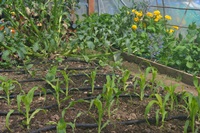
Soaker hose irrigation kit from Easy Watering
Before I explain what he’s been up to in the garden, there are a few things you might like to know about using irrigation systems.
Some people enjoy the (sometimes twice) daily hand watering regimes demanded during the warmer months. They find it therapeutic and a good opportunity to see how the plants are growing, something that can get overlooked once an irrigation system is in place. Careful hand watering will make sure that each and every plant will receive the adequate water supply necessary for its needs. That said, depending upon the size of your greenhouse, polytunnel or garden, hand watering can take up a huge chunk of your time, something that many of us seem to struggle to find.
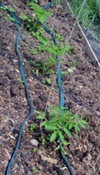
Cheap & Inefficient Leaky Hose Irrigation Kit
Sprinkler systems can cover large areas and are often popular in industrial sized greenhouses, but they spray water everywhere, usually from above, which can be an invitation for fungal diseases if the water sits on leaves for too long.
Drip irrigation systems can work well and it’s worth spending the money on a decent one as we’ve found the cheaper versions can be tricky to set up. They can be directed in such a way that water slowly drips directly to the roots of plants, exactly where it’s needed.
Soaker Hose kits consist of porous pipes that allow water to seep out gently. You can usually adjust the flow, rate and pressure of water making them very user-friendly. The kit we were given by Easy Watering is very good quality and Mr G found it easy to configure.
However, we would only consider using this porous pipe when fitted to a rainwater collection tank. If we were to fit it to our well water supply the pump would be turning on and off all day causing an increase in electricity costs and a drain on the filtration system and well water supply.
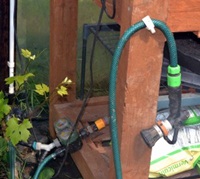
Irrigation time and spray attachment
The sprinkler and drip irrigation systems can be connected to a standard hose and to conserve water, it’s a good idea to connect the hose to a timer which will make sure you don’t turn on the tap then walk away and forget about it.
For more detailed information about the different watering systems and connections available, take a look at the Easy Watering website.
How We Connected An Irrigation Kit to a Upcycled Rainwater Harvesting Tank
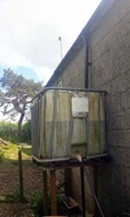
Upcycled water tank for rainwater harvesting
A few years ago we were given a 1000 litre builders water tank that was no longer in use which Mr G connected to the guttering system at the back of the house. The tank is elevated as a certain amount of water pressure is needed to send the water down the connecting hose and along the twenty metres or so to the polytunnel.
In the centre aisle of our polytunnel the Easy Watering seepage pipe has been connected directly to the rainwater hose (see the large photos above and below).
The soakage pipe gently seeps a small amount of rainwater at soil level throughout the day and night. Plants can drown if they’re given too much water but the adjustable fittings on the pipe prevent this happening.
Connecting the pipe directly to the rainwater tank means that should it run dry, we can revert to hand watering with a watering can until it rains again and the tank refills. Given that long-term drought in Ireland is rare, that scenario is unlikely to happen too often.
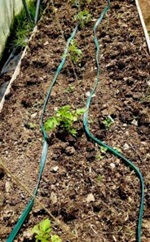
irrigated tomatoes
The other two beds inside the polytunnel have a drip/spray irrigation system connected to a timer unit from hose running off an outside tap connected to the well.
We bought this particular pipe cheaply a couple of years ago before we went to America for the summer months, knowing that we had no choice but to irrigate (see photo on the left).
The water timer is set to run for ten minutes at 6am and 6pm and is battery-powered.
Our longer term plan is to add more rainwater tanks to the system, insulating them to prevent damage from frost and UV sunlight and to switch over completely to a soaker hose system run purely from captured rainwater, making the irrigation system completely self sustainable.
Although there’s an initial outlay involved with setting up an irrigation system we feel this is a good investment. If the equipment is looked after it can be used for many years to come.
Installing an irrigation system ensures a steady water supply to plants and means we can leave the house in the summer months for longer than a day, safe in the knowledge that our plants are being watered and they wont be lost to drought.
Connecting an irrigation system to a rainwater supply makes it the most sustainable and therefore most environmentally friendly way of watering plants and the water wont cost you a cent either.

irrigation timer unit – 2 hose outlets with a washing machine connector giving 3.
I can’t emphasis enough the importance of a timer for the drip and sprinkler systems as it will make sure water isn’t wasted. The batteries ran out on our timer unit once and I can tell you from experience that it’s incredibly easy to forget you’ve switched the hose on and walk away and leave it for several hours!
As regards the two watering systems we’ve now installed, in hindsight it would have been better to have paid a bit more at the beginning and brought good quality kit such as that provided by Easy Watering and got the system right. This would have ensured that all the plants get the water they need and not the polytunnel roof or the walkways, as happens with the cheaper hoses. Like many things, buying cheap hose can be wasted economy as it just doesn’t work as well.

Soaker Hose Irrigation Kit
As for the plants…? Ours are loving the extra water they’re receiving as a result of the new seepage hose. The sweet corn and dwarf beans are flying up and there’s no doubt it’s as a result of the additional water they’re receiving. I’m also fairly confident the extra moisture will keep the red spider mite away that we were plagued with last year as they don’t like wet conditions.
Are you a fan of irrigation systems? Do you think it’s something you’d try?

Dee Sewell – a horticulturalist and certified trainer who started Greenside Up in 2009 and teaches people how to grow vegetables. Dee specialises in working with community gardens but also offers workshops, allotment visits, consultations, horticultural therapy, afterschools clubs as well as local talks – she tailors her services to meet clients needs. In 2012 Dee launched a Seed Gift Collection containing varieties of vegetable and insect friendly flowers with the aim of getting more people growing. Dee’s blog was a finalist in the 2012 Ireland Blog Awards in the Eco/Green and Lifestyle Categories.
Source: Greenside Up – How to Set Up A Rainwater Irrigation System for Your Garden – Dee Sewell





